Located in the southwestern corner of India, Kerala is a prime destination for bird enthusiasts, featuring a remarkable array of 567 bird species.
This dynamic state combines lush landscapes with diverse ecosystems, drawing avian species from around the world.
From the dignified Western Ghats to peaceful backwaters, each environment serves as a refuge for both indigenous and migratory birds.
Kerala’s extensive birdlife includes everything from vibrant kingfishers to the rare Blue-capped Rock Thrush, making it an essential spot for birdwatchers.
The region’s distinct climate and topography provide optimal conditions for these species to flourish, offering insight into the complex interplay of nature.
Whether a casual observer or an experienced ornithologist, Kerala’s birdlife offers a fascinating experience, demonstrating the state’s dedication to preserving its natural heritage.
37 Birds in Kerala
Kerala, a state in India, is renowned for its rich avian biodiversity. The region is home to a diverse array of bird species, with estimates ranging from 379 to 567 species recorded across various surveys.
1. Cotton Pygmy Goose
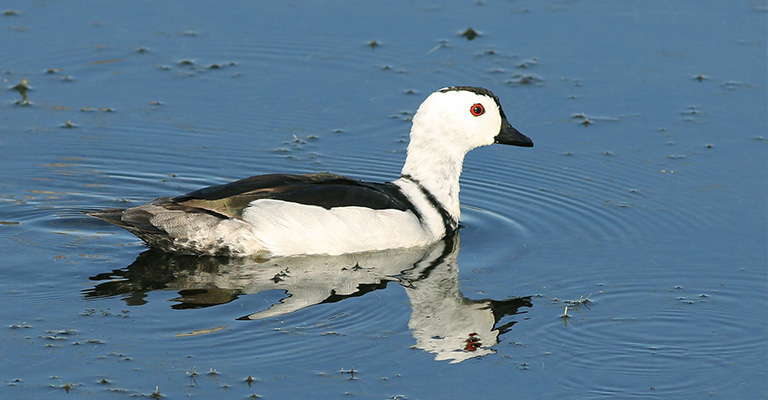
The Cotton Pygmy Goose thrives in Kerala’s wetlands and ponds. This diminutive duck often nests in tree hollows. Males boast striking green and white plumage.
Females have more subdued, mottled feathers. Frequently seen paddling in pairs, these birds feed on aquatic vegetation.
Their presence indicates healthy wetland ecosystems. Despite their name, these geese rarely migrate. Habitat loss, however, poses a threat to their populations.
Conservation efforts in Kerala aim to protect their natural habitats. Observing these geese offers birdwatchers delightful insights into avian behavior.
Scientific classification:
| Kingdom | Animalia |
| Phylum | Chordata |
| Class | Aves |
| Order | Anseriformes |
| Family | Anatidae |
| Genus | Nettapus |
| Species | N. coromandelianus |
Also Featured In: Most Common Birds in China, Native Birds Of Mackay
2. Lesser Whistling Duck
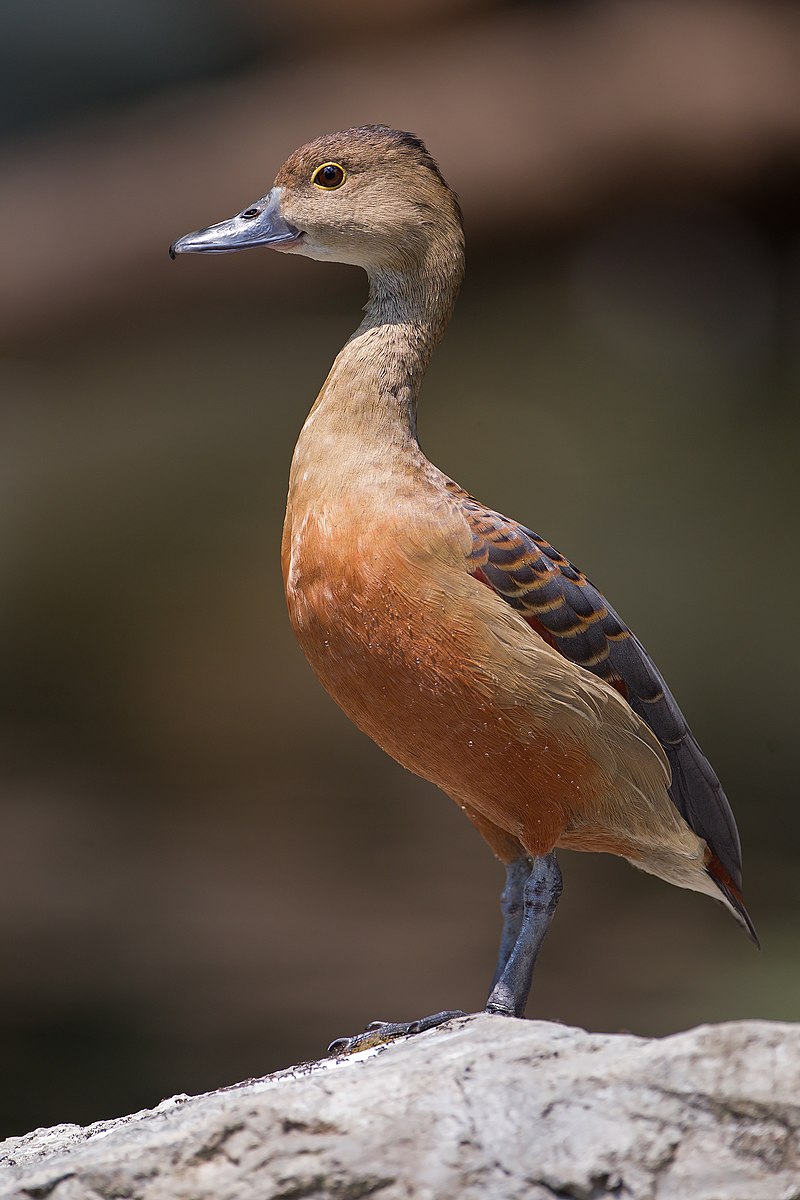
Lesser Whistling Ducks delight birdwatchers in Kerala’s lush wetlands. These ducks, known for their soft calls, are often spotted in pairs or small flocks.
Their distinct whistling, especially at dawn and dusk, adds a charming soundscape to the region. They thrive on a diet of seeds and small aquatic invertebrates, making them vital to the ecosystem.
They play a role in keeping waterways healthy. Their presence in places like Kannur underscores the biodiversity richness of Kerala’s landscapes.
Scientific classification:
| Kingdom | Animalia |
| Phylum | Chordata |
| Class | Aves |
| Order | Anseriformes |
| Family | Anatidae |
| Genus | Dendrocygna |
| Species | D. javanica |
Also Featured In: Most Common Birds of Ko Samui, Ko Samet Birds You Need To Know
3. Grey Junglefowl
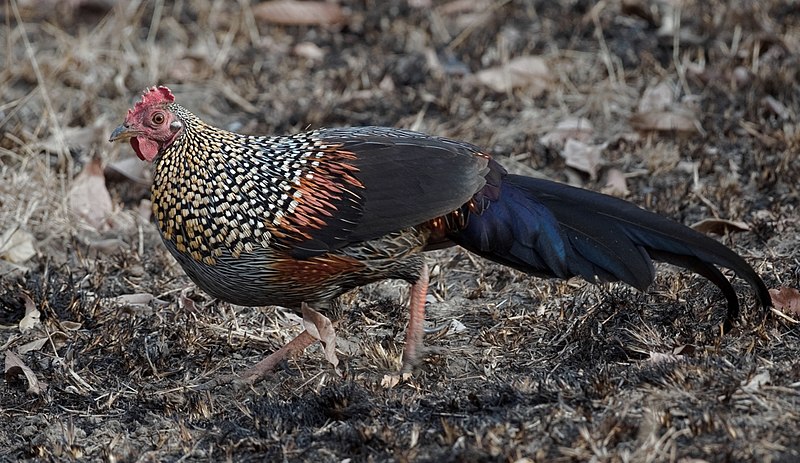
The Grey Junglefowl, or Gallus sonneratii, thrives in Kerala’s dense forests. Known for their striking plumage, males exhibit vibrant orange plumage with long tail feathers.
Roaming the underbrush, these birds forage for seeds, insects, and fruits. They hold cultural importance as ancestors to domestic chickens.
With calls echoing through the woods, they offer birdwatchers vibrant glimpses during dawn and dusk. Conservationists emphasize its protection due to habitat intrusion and hunting, ensuring it remains a forest symbol.
Scientific classification:
| Kingdom | Animalia |
| Phylum | Chordata |
| Class | Aves |
| Order | Galliformes |
| Family | Phasianidae |
| Genus | Gallus |
| Species | G. sonneratii |
Also Featured In: Common Birds in India, Birds that Live in Rajasthan
4. Greater Coucal
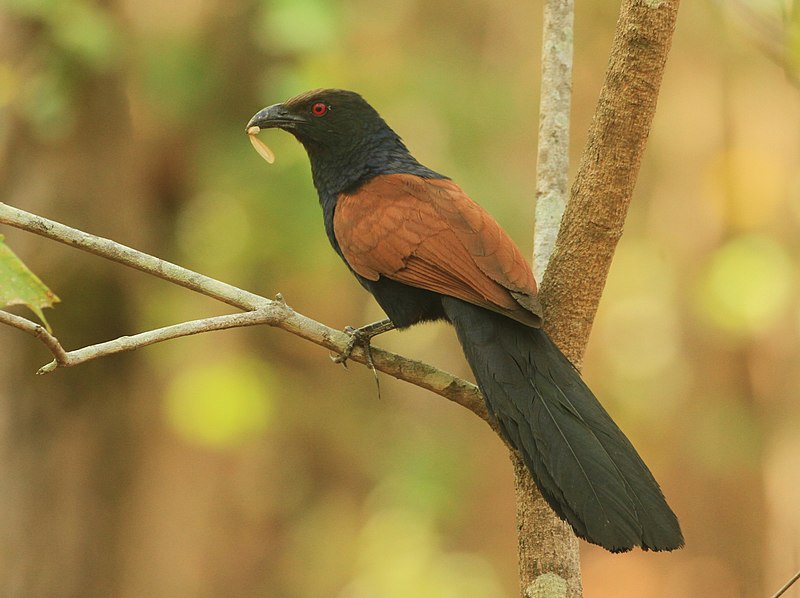
The Greater Coucal, prominent in Kerala’s avian landscape, captivates with its deep blackish-purple body and chestnut wings.
These birds, known for their distinct ‘oop-oop-oop’ calls, inhabit dense shrubs and gardens. They primarily feed on insects, small reptiles, and seeds, contributing to pest control.
They are often spotted in pairs, leisurely exploring the underbrush. Their unmistakable appearance and evocative calls make them a favorite among birdwatchers.
These coucals thrive in both rural and urban settings, adding vibrancy to Kerala’s rich biodiversity.
Scientific classification:
| Kingdom | Animalia |
| Phylum | Chordata |
| Class | Aves |
| Order | Cuculiformes |
| Family | Cuculidae |
| Genus | Centropus |
| Species | C. sinensis |
Also Featured In: Hong Kong Birds You Need to See, Birds that Commonly Found in Andhra Pradesh
5. White-Throated Kingfisher
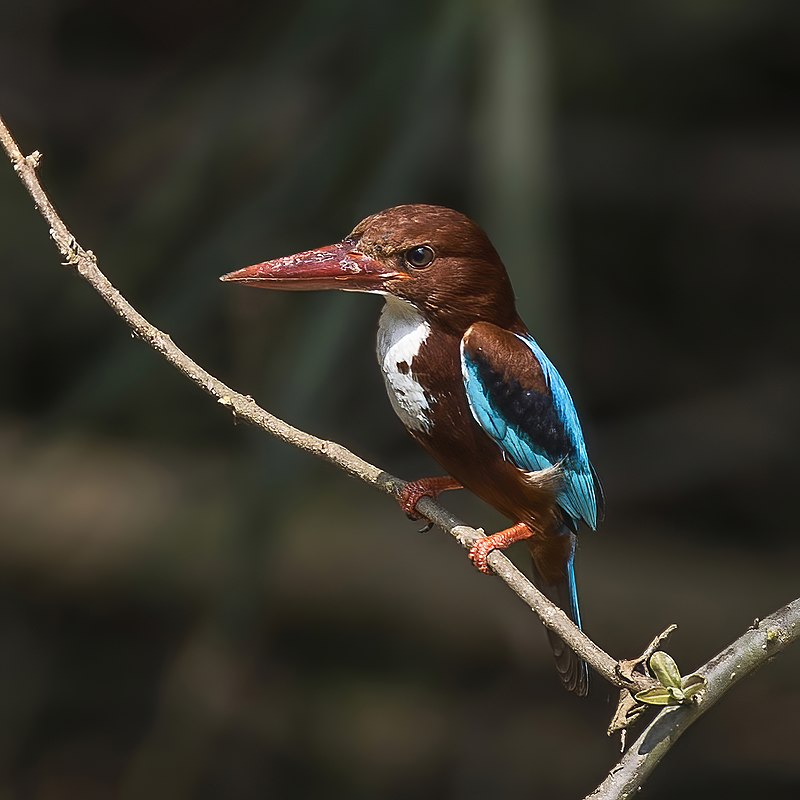
Bright hues of turquoise and chestnut define the White-Throated Kingfisher. This bird frequents Kerala’s wetlands, forests, and urban areas, showcasing its adaptability.
Its diet consists of small fish, amphibians, and insects, highlighting a versatile hunting strategy. The bird’s signature call is a piercing whistle that echoes in diverse habitats.
Observers often spot it perched on branches, scanning for prey with keen eyes. Known scientifically as Halcyon smyrnensis, this kingfisher exemplifies Kerala’s vibrant avian diversity.
Scientific classification:
| Kingdom | Animalia |
| Phylum | Chordata |
| Class | Aves |
| Order | Coraciiformes |
| Family | Alcedinidae |
| Subfamily | Halcyoninae |
| Genus | Halcyon |
| Species | H. smyrnensis |
Also Featured In: Turkey Birds You Should Know, Lebanon Birds Live in Semi-Desert Areas
6. Grey-Headed Swamphen
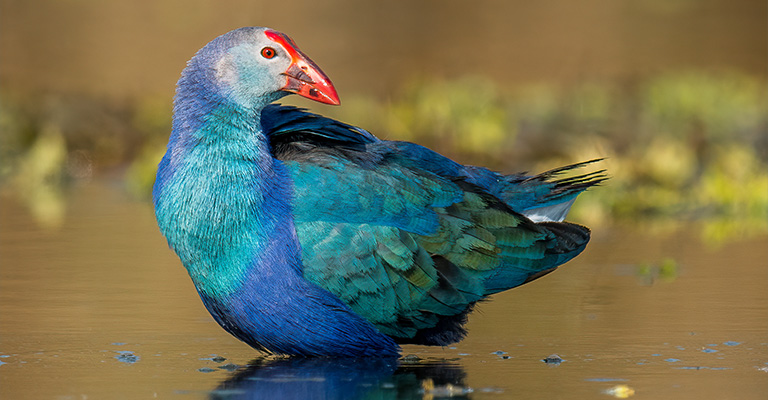
Grey-headed swamphens grace Kerala’s wetlands with their vibrant blue and purple plumage. These large wading birds thrive in the state’s abundant marshlands, feeding on reeds and aquatic plants.
They are often seen in groups, navigating the shallow waters with ease. Vembanad Lake is a popular site for spotting these swamphens, where they add a splash of color.
Watching these birds offers an engaging view into Kerala’s rich avian ecosystem, appealing to nature enthusiasts across the region.
Scientific classification:
| Kingdom | Animalia |
| Phylum | Chordata |
| Class | Aves |
| Order | Gruiformes |
| Family | Rallidae |
| Genus | Porphyrio |
| Species | P. poliocephalus |
Also Featured In: Magenta Birds You Didn’t Know,
7. Indian Pond Heron
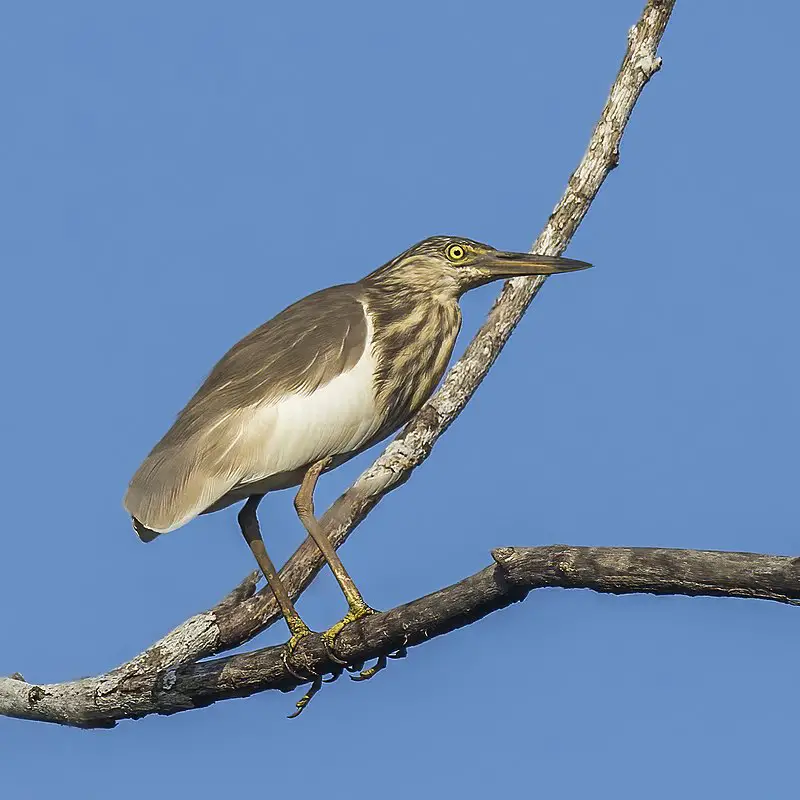
The Indian Pond Heron thrives in Kerala’s wetlands and paddy fields. Often disguised in its environment, it surprises observers by blending in until taking flight.
Sporting white wings in contrast to its brown body, it offers a striking view during flight. This heron primarily feeds on fish, insects, and small amphibians, contributing to pest control.
An adept hunter, it patiently waits for prey before swiftly striking. The Indian Pond Heron enriches Kerala’s avian diversity, intriguing birdwatchers with its stealth and adaptability.
Scientific classification:
| Kingdom | Animalia |
| Phylum | Chordata |
| Class | Aves |
| Order | Pelecaniformes |
| Family | Ardeidae |
| Genus | Ardeola |
| Species | A. grayii |
Also Featured In: Native Pakistani Birds, Birds of Islamabad
8. Rufous Treepie
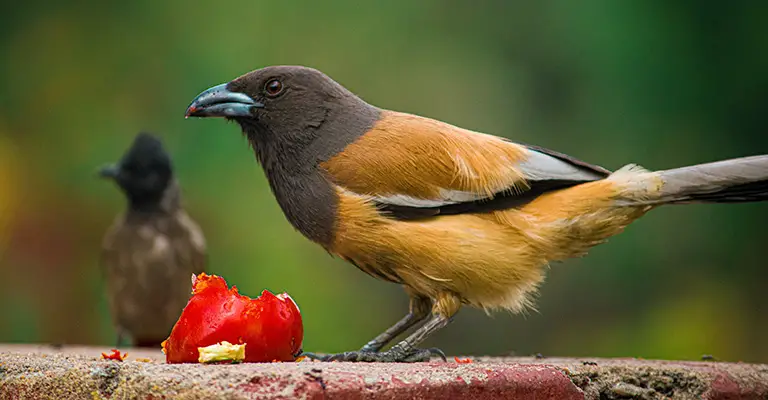
Spotting the Rufous Treepie in Kerala is a delight for bird enthusiasts. Known scientifically as Dendrocitta vagabunda, this bird’s striking orange-brown plumage captivates observers.
Predominantly found in Kozhikode, it’s a member of the Corvidae family, sharing traits with crows and magpies.
Often seen exploring forests, it feeds on fruits, insects, and small reptiles. Playful in nature, it uses a variety of calls to communicate. Observers can often hear these calls resonating through Kerala’s rich landscapes.
Scientific classification:
| Kingdom | Animalia |
| Phylum | Chordata |
| Class | Aves |
| Order | Passeriformes |
| Family | Corvidae |
| Genus | Dendrocitta |
| Species | D. vagabunda |
Also Featured In: Birds that Live in Uttar Pradesh, Birds that You’ll Find in Kolkata
9. Common Myna
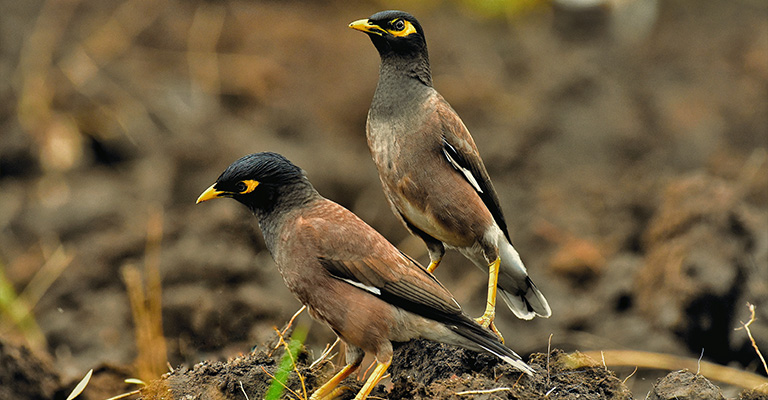
Common Mynas often brighten up Kerala’s landscapes with their distinctive brown bodies and yellow eye patches.
They thrive in urban gardens and rural areas, making them a familiar sight across the region. These birds possess a remarkable ability to mimic human speech and other sounds, adding a playful element to their charm.
Known scientifically as Acridotheres tristis, Common Mynas feed primarily on insects and fruits, contributing to the local ecosystem’s balance. Their sociable nature and adaptability make them a favorite among birdwatchers in Kerala.
Scientific classification:
| Kingdom | Animalia |
| Phylum | Chordata |
| Class | Aves |
| Order | Passeriformes |
| Family | Sturnidae |
| Genus | Acridotheres |
| Species | A. tristis |
Also Featured In: Most Common Types of Bangladeshi Birds, Birds of Kauai, Hawaii
10. Darters
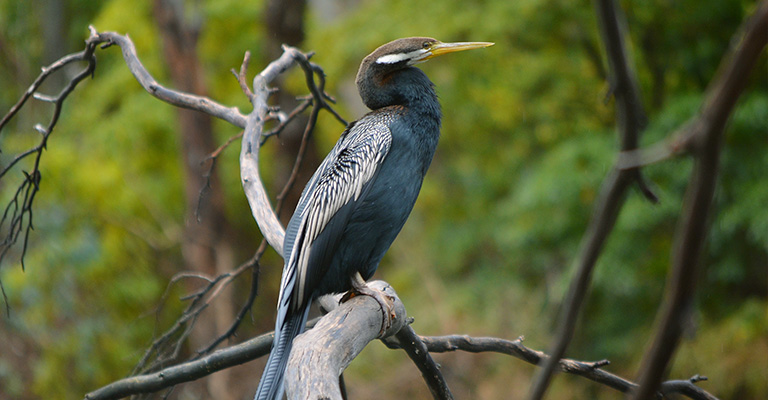
Darters, also known as snakebirds, enthrall birdwatchers with their slender necks that resemble a snake. Typically, these birds submerge their bodies while swimming, presenting a fascinating image.
Males flaunt striking black and dark brown plumage, while females exhibit paler feathers on their necks and underparts. Darters possess webbed feet that allow them to dive efficiently.
After a swim, they often spread their wings to dry—similar behavior to cormorants—adding a captivating sight in Kerala’s diverse waterways.
Scientific classification:
| Kingdom | Animalia |
| Phylum | Chordata |
| Class | Aves |
| Order | Suliformes |
| Family | Anhingidae Reichenbach, 1849[1] |
| Genus | Anhinga Brisson, 1760 |
Also Featured In: Water Birds Live around Us, South Australian Birds
11. Brahminy Kite
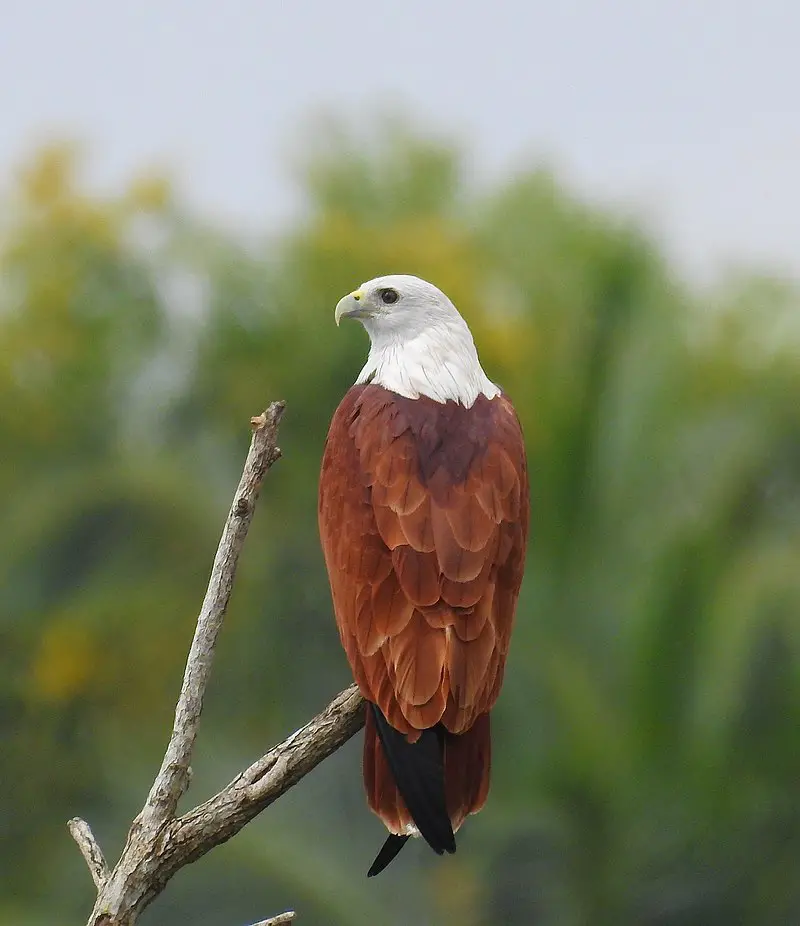
The Brahminy Kite dazzles nature enthusiasts with its striking chestnut and white plumage. Living primarily along coasts and rivers in Kerala, this bird of prey boasts a distinct V-shaped tail.
It skillfully soars the skies, searching for fish and small mammals. Known for its adaptable diet, it also scavenges for carrion.
Encounter it gracefully flying over wetlands and rice fields, providing breathtaking aerial displays. As a member of the Accipitridae family, it highlights Kerala’s avian beauty.
Scientific classification:
| Kingdom | Animalia |
| Phylum | Chordata |
| Class | Aves |
| Order | Accipitriformes |
| Family | Accipitridae |
| Genus | Haliastur |
| Species | H. indus |
Also Featured In: Birds that Live around Brisbane, Birds that Charles Darwin Studied
12. White-Breasted Waterhen
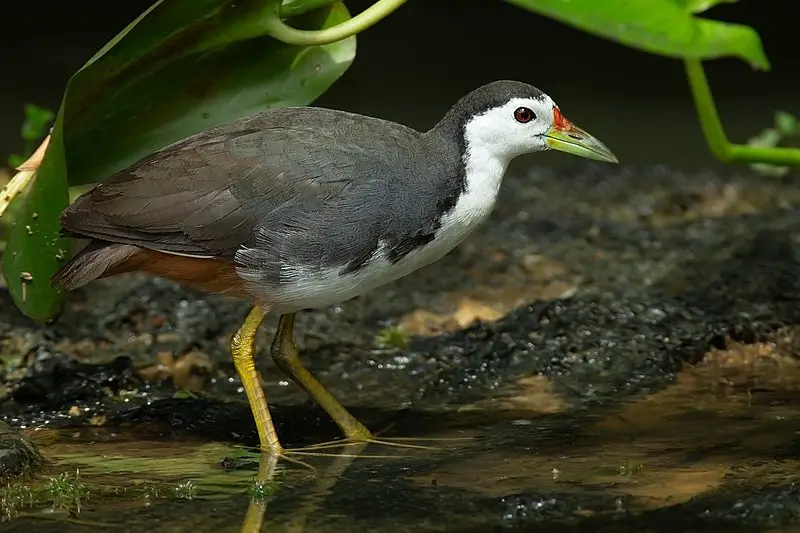
The White-Breasted Waterhen wades gracefully through Kerala’s wetland habitats. Found in marshes and paddy fields, this bird is recognizable by its white face and underparts contrasting with dark upper body feathers.
It thrives on a diet of insects, small fish, and seeds, contributing to ecological balance. Its characteristic clucking calls often echo in early morning and evening hours, making it a sought-after sight for birdwatchers exploring Kerala’s rich and diverse landscapes.
Scientific classification:
| Kingdom | Animalia |
| Phylum | Chordata |
| Class | Aves |
| Order | Gruiformes |
| Family | Rallidae |
| Genus | Amaurornis |
| Species | A. phoenicurus |
Also Featured In: Birds that Commonly Found in Bali, Big Birds that Live in Singapore
13. Asian Green Bee-Eater
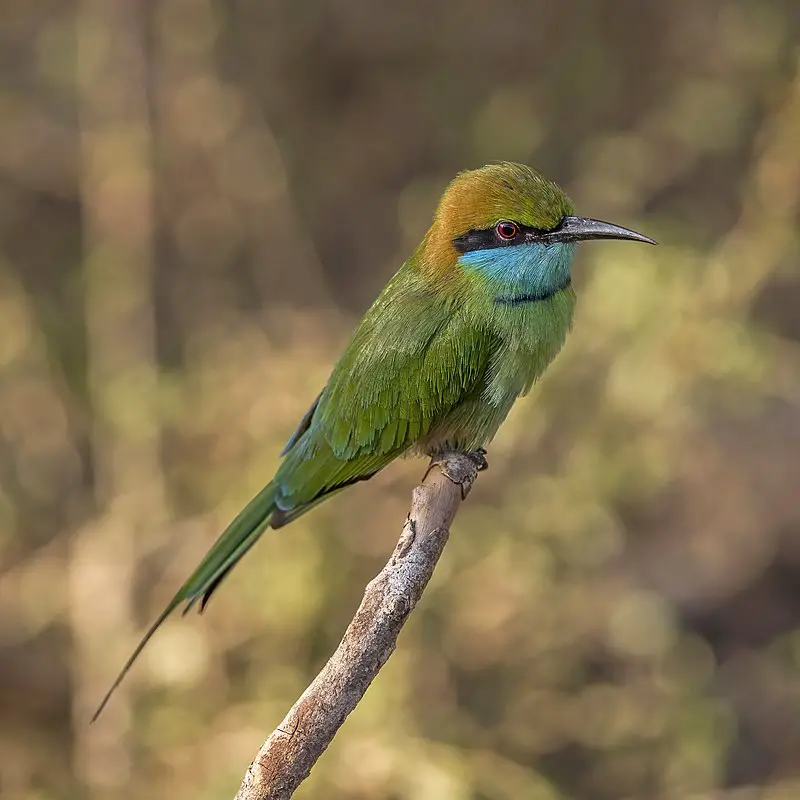
Found gracing Kerala’s open fields and wooded areas, the Asian Green Bee-Eater captivates with its vibrant emerald plumage.
Regularly observed during warm climates, these birds bring a splash of color to the landscape. They expertly hover mid-air before diving to catch insects, showcasing their remarkable agility.
Known scientifically as Merops orientalis, they often gather in small flocks, enriching the region’s avian diversity.
Their slender bodies and pointed tails add to their elegance and foster birdwatchers’ admiration in Kerala’s diverse habitats.
Scientific classification:
| Kingdom | Animalia |
| Phylum | Chordata |
| Class | Aves |
| Order | Coraciiformes |
| Family | Meropidae |
| Genus | Merops |
| Species | M. orientalis |
Also Featured In: Birds You’ll Find in Kanha National Park, Birds of Konkan
14. Black Drongo
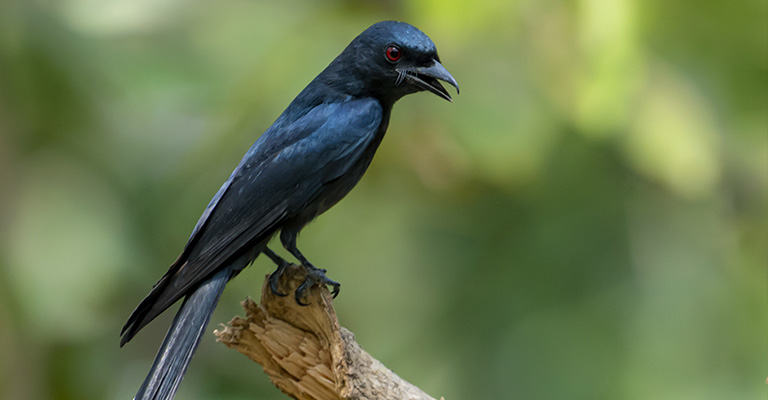
The Black Drongo, scientifically known as Dicrurus macrocercus, frequently perches in Kerala’s open fields and urban areas.
Sporting stark black feathers with a forked tail, it surprises many with occasional metallic tints. Always ready for a feast, this bird captures insects mid-air or off the ground, showcasing its agile flight.
Preferring to perch high, it sits in an upright position like a shrike. A familiar sight and sound, the Black Drongo contributes to Kerala’s rich birdlife.
Scientific classification:
| Kingdom | Animalia |
| Phylum | Chordata |
| Class | Aves |
| Order | Passeriformes |
| Family | Dicruridae |
| Genus | Dicrurus |
| Species | D. macrocercus |
Also Featured In: Most Common Taiwan Birds, Delhi Birds You Need to See
15. Frogmouth
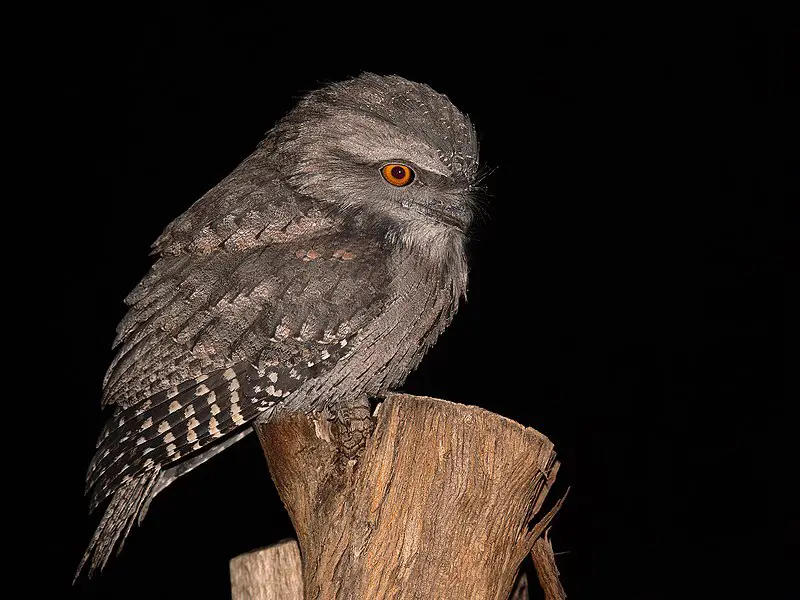
Thriving in Kerala’s dense forests, the Frogmouth fascinates with its unique appearance and nocturnal habits.
Bearing a distinct flat, wide bill, these birds blend seamlessly with tree branches during the day. With brown and mottled plumage, they camouflage expertly, evading predators.
Known for their haunting calls, these birds animate the night, providing a mysterious allure to Kerala’s biodiversity.
Birdwatchers cherish the challenge of spotting them, as their cryptic nature adds an intriguing twist to any avian adventure in the region.
Scientific classification:
| Kingdom | Animalia |
| Phylum | Chordata |
| Class | Aves |
| Clade | Strisores |
| Order | Podargiformes Matthews, 1918 |
| Family | Podargidae Gray, 1847 |
Also Featured In: Birds of the Philippines, Common Philippines Birds
16. Blue-Tailed Bee-Eater
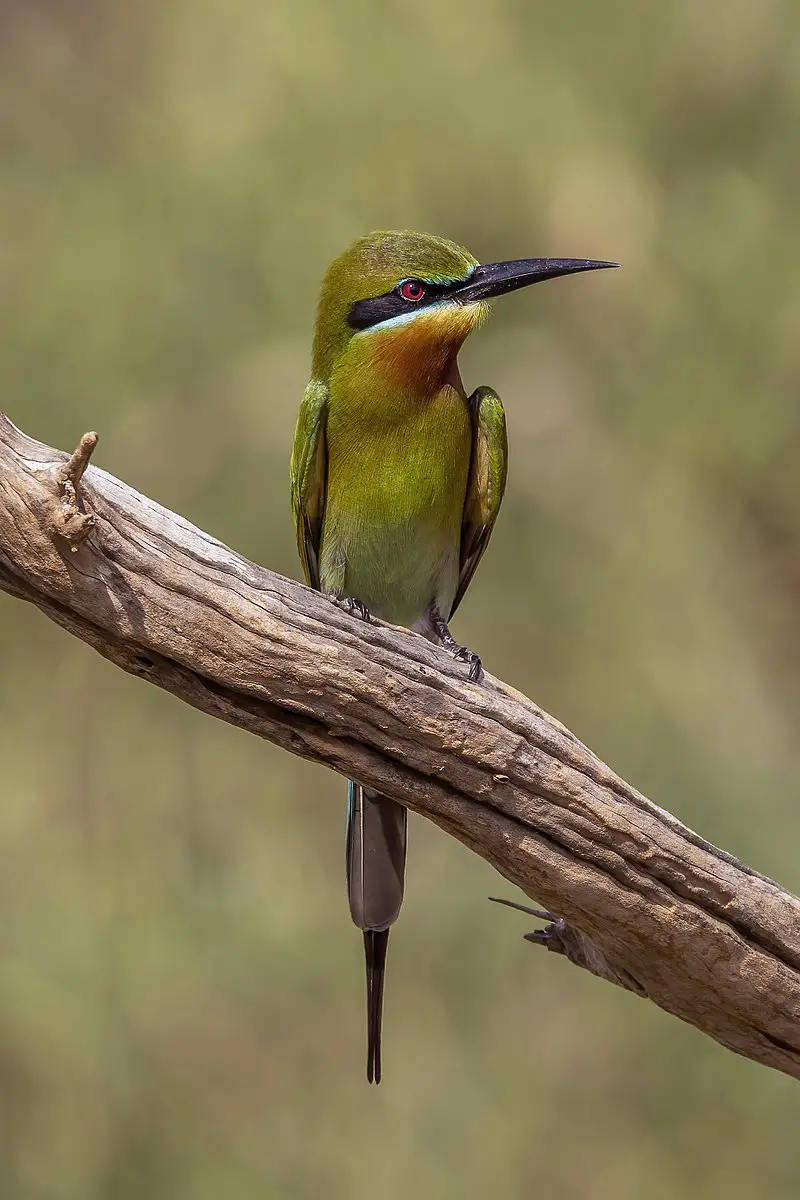
The Blue-Tailed Bee-Eater is a striking presence among Kerala’s avian species. Sporting vibrant blue and green plumage, its tail feathers add a distinct charm.
Found mainly in open fields and beaches, they often perch on wires. Unlike other birds, it catches insects mid-flight with incredible precision.
Always seen in small groups, the Blue-Tailed Bee-Eater contributes significantly to the region’s ecological balance.
Enthusiasts visiting Kerala can enjoy spotting these beautifully colored birds, enriching their birdwatching experience.
Scientific classification:
| Kingdom | Animalia |
| Phylum | Chordata |
| Class | Aves |
| Order | Coraciiformes |
| Family | Meropidae |
| Genus | Merops |
| Species | M. philippinus |
Also Featured In: Birds That Live In Phuket Island,
17. Whiskered Tern
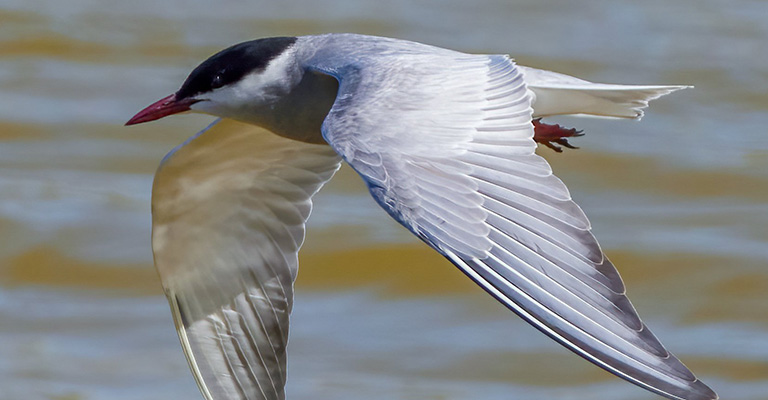
Perched gracefully on Kerala’s water bodies, the Whiskered Tern catches the eye with its gray and white plumage.
Known scientifically as Chlidonias hybrida, this bird frequents marshlands and lakes, harmonizing with aquatic ecosystems.
It feeds primarily on fish and insects, diving elegantly to secure its meal. Often spotted in small flocks, the Whiskered Tern adds vibrancy to Kerala’s diverse birdlife.
Birdwatchers are drawn to its agile flight and melodious calls, enriching their exploration of the state’s rich avian habitats.
Scientific classification:
| Kingdom | Animalia |
| Phylum | Chordata |
| Class | Aves |
| Order | Charadriiformes |
| Family | Laridae |
| Genus | Chlidonias |
| Species | C. hybrida |
Also Featured In: Most common Birds in France, Common Serbian Birds
18. Hornbill
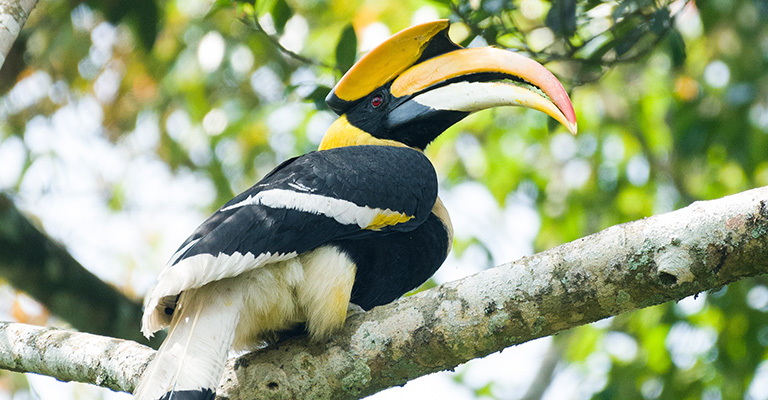
Kerala hosts several striking hornbills, including the Great Hornbill, Malabar Pied Hornbill, and Indian Grey Hornbill.
Each bird features a distinctive casque atop its vibrant bill. Often found in dense forests, these birds play a crucial role by dispersing seeds of larger fruiting trees.
Their diet includes fruits, insects, and small animals. These hornbills’ unique calls resonate through the wooded landscapes, making them a favorite among birdwatchers exploring Kerala.
Scientific classification:
| Kingdom | Animalia |
| Phylum | Chordata |
| Class | Aves |
| Order | Bucerotiformes |
| Family | Bucerotidae Rafinesque, 1815 |
Also Featured In: Birds of South African, African Birds
19. Great Hornbill
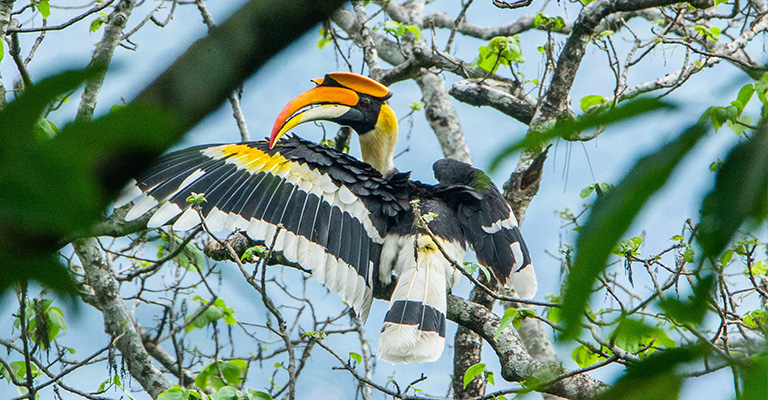
The Great Hornbill, Kerala’s state bird, impresses with its massive size. This bird, found in evergreen forests, showcases a striking yellow bill with a black casque.
Females, smaller than males, feature blue eyes. Its black-feathered body is complemented by a fur-lined neck.
Thriving from sea level to 5,000 feet, this hornbill’s short legs and broad feet are suited for its habitat. Its near-threatened status underscores habitat loss concerns, highlighting conservation needs in Kerala’s lush landscapes.
Scientific classification:
| Kingdom | Animalia |
| Phylum | Chordata |
| Class | Aves |
| Order | Bucerotiformes |
| Family | Bucerotidae |
| Genus | Buceros |
| Species | B. bicornis |
Also Featured In: Birds of Myanmar, Common Tropical Rainforest Birds
20. Red-Whiskered Bulbul
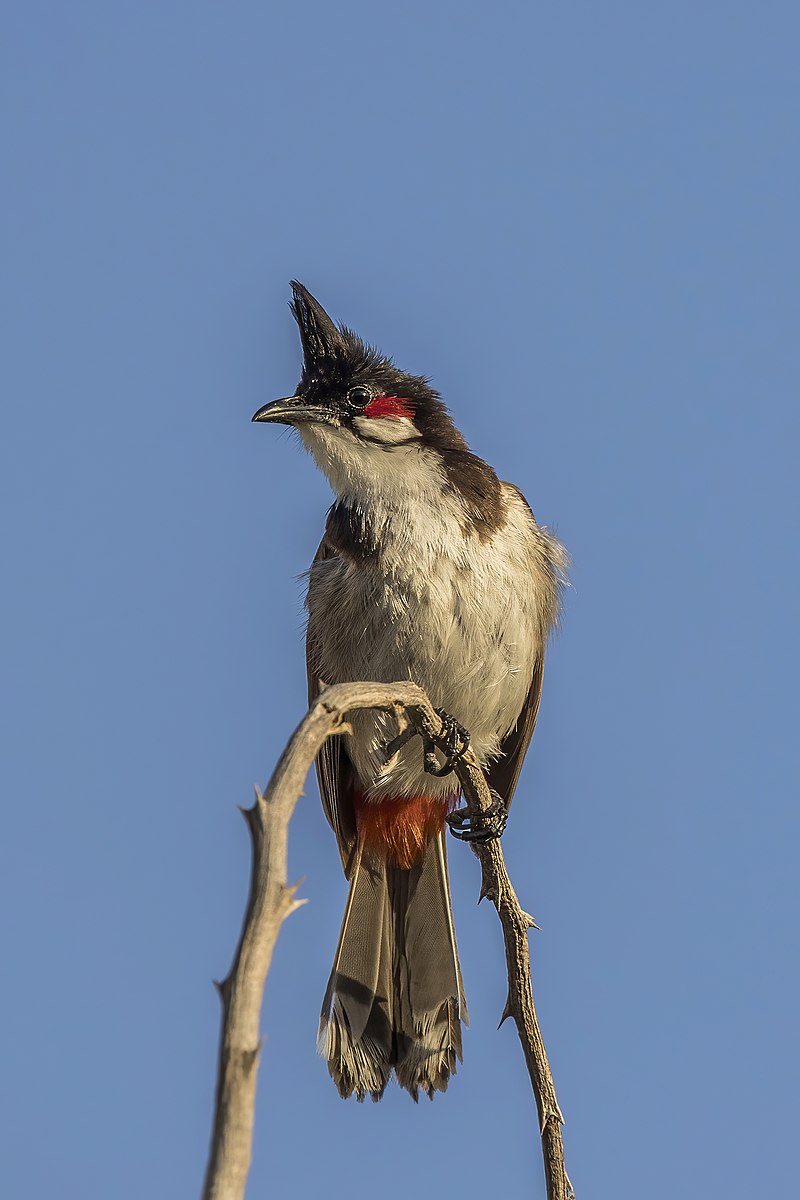
Red-Whiskered Bulbul stands out with bright red patches beneath its eyes. These lively birds are frequently seen perched in gardens and parks throughout Kerala.
Known scientifically as Pycnonotus jocosus, they charm observers with their melodious calls. They feed primarily on fruits and insects, playing a role in seed dispersal.
Often spotted in pairs or small groups, their social nature adds zest to their presence. With their distinctive crest and lively demeanor, they are a favorite among birdwatchers exploring Kerala.
Scientific classification:
| Kingdom | Animalia |
| Phylum | Chordata |
| Class | Aves |
| Order | Passeriformes |
| Family | Pycnonotidae |
| Genus | Pycnonotus |
| Species | P. jocosus |
Also Featured In: Common Birds of Mumbai, Common Birds of Jharkhand
21. Crested Honey Buzzard
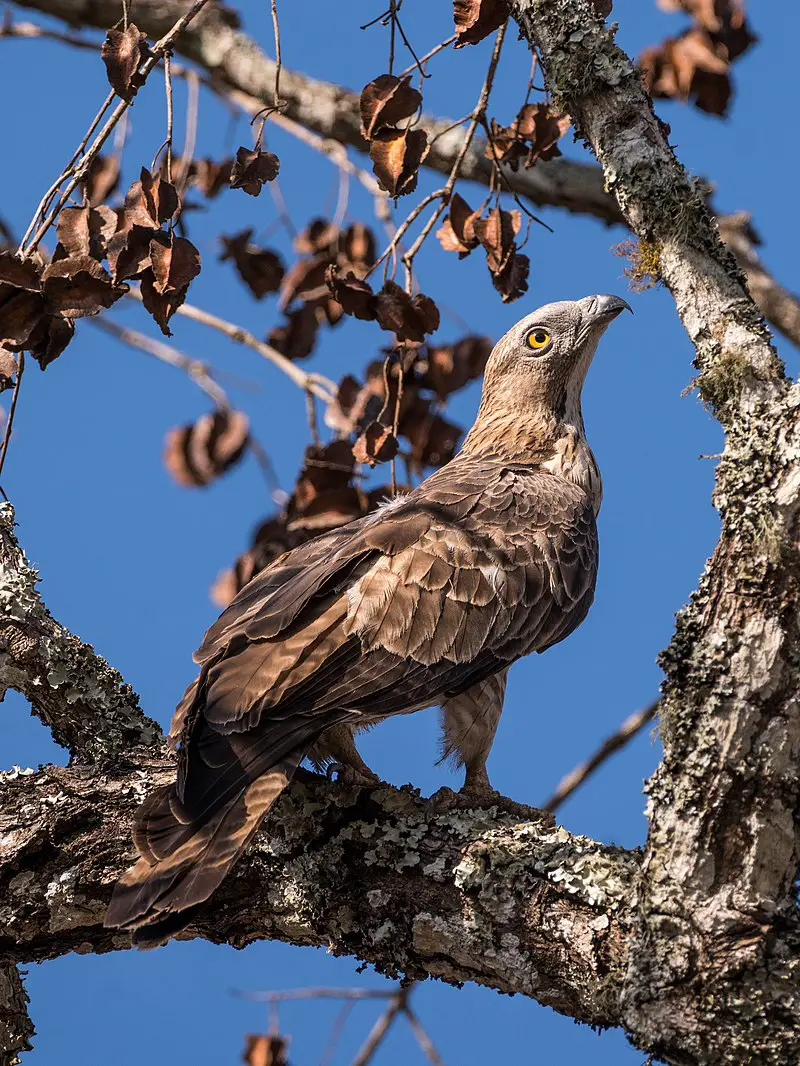
The Crested Honey Buzzard adds an exotic touch to Kerala’s skies. Known for its distinctive crest and subtle plumage, this bird of prey showcases an elegant silhouette while soaring above forests.
Feeding mainly on honeycombs and larvae, it plays a unique role in its ecosystem. Often confused with other raptors, the Crested Honey Buzzard is identified by its long tail and distinct flight pattern.
Birdwatchers in Kerala relish spotting this elusive bird during migration periods, adding a fascinating element to their observations.
Scientific classification:
| Kingdom | Animalia |
| Phylum | Chordata |
| Class | Aves |
| Order | Accipitriformes |
| Family | Accipitridae |
| Genus | Pernis |
| Species | P. ptilorhynchus |
Also Featured In: Native South Korean Birds,
22. Black-Hooded Oriole
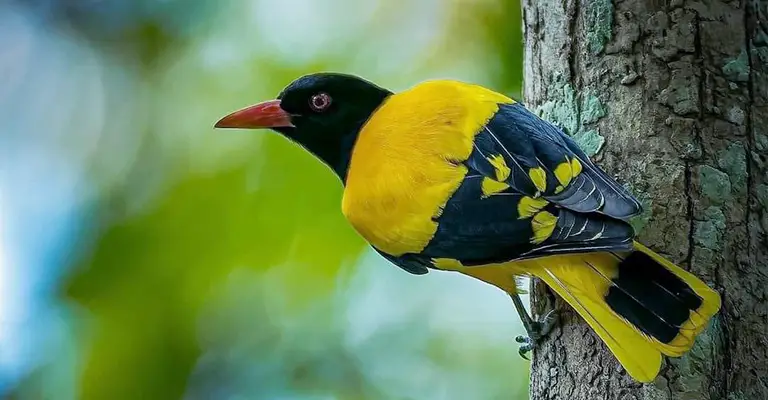
The Black-Hooded Oriole, scientifically called Oriolus xanthornus, captivates with its vivid yellow and contrasting black head.
Known for melodious calls, they thrive in Kerala’s lush woodlands and gardens. Feeding on fruits, insects, and nectar, they contribute to pollination and seed dispersal.
Observers often delight in spotting these vibrant birds perched high in the canopy, adding a splash of color and music to Kerala’s rich avian tapestry.
Scientific classification:
| Kingdom | Animalia |
| Phylum | Chordata |
| Class | Aves |
| Order | Passeriformes |
| Family | Oriolidae |
| Genus | Oriolus |
| Species | O. xanthornus |
Also Featured In: Common Birds Found in Nepal, Birds that You’ll Find in Kruger national park
23. Malabar Pied Hornbill
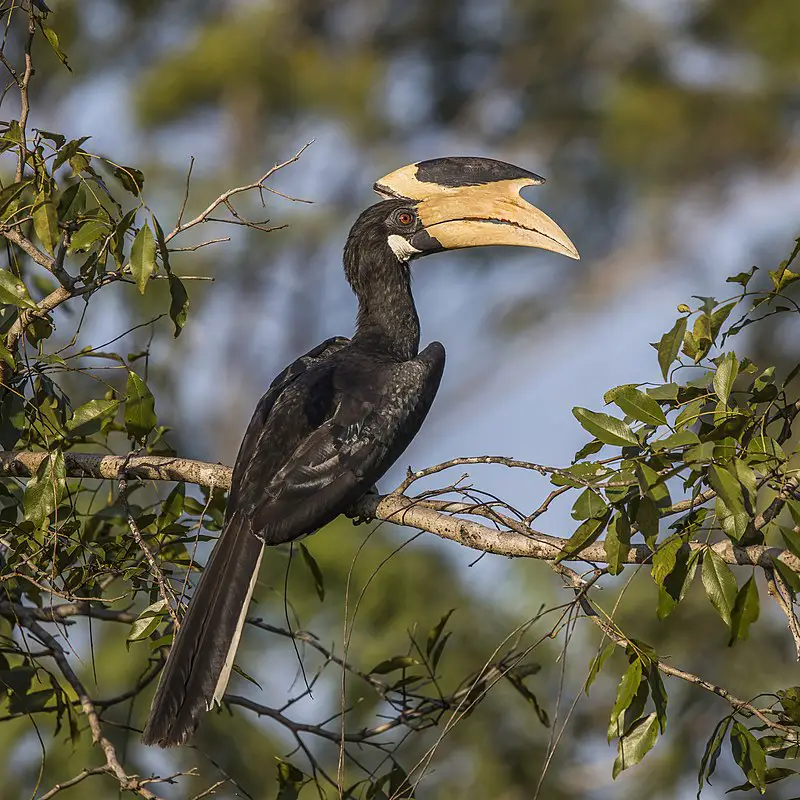
The Malabar Pied Hornbill thrives in Kerala’s evergreen forests. Sporting a large, curved bill and striking black and white plumage, it captivates birdwatchers.
Often seen foraging for fruits, especially figs, it plays an essential role in seed dispersal. Easily recognized by its prominent casque, it often mingles with other frugivorous birds.
A common sight along the Western Ghats, this hornbill enriches Kerala’s avian diversity and draws nature enthusiasts year-round.
Scientific classification:
| Kingdom | Animalia |
| Phylum | Chordata |
| Class | Aves |
| Order | Bucerotiformes |
| Family | Bucerotidae |
| Genus | Anthracoceros |
| Species | A. coronatus |
Also Featured In: Birds in Sri Lanka,
24. Drongos
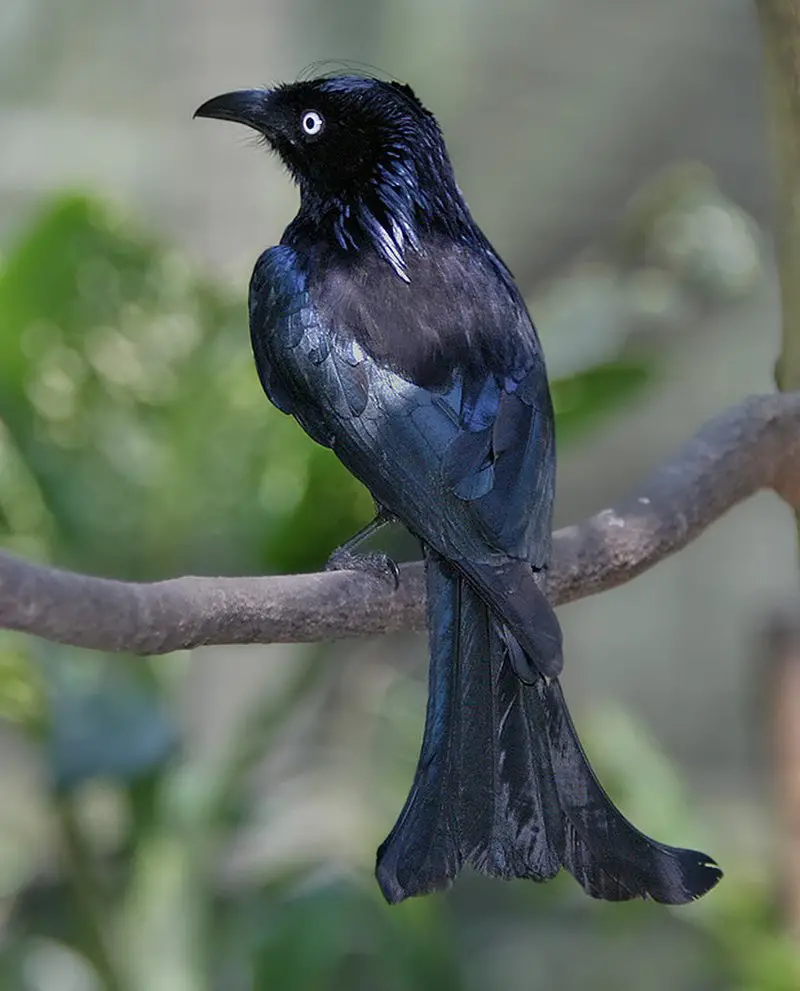
Drongos, with their glossy black feathers, are a common sight in Kerala’s landscapes. Known scientifically as Dicrurus, these birds display remarkable aerial agility.
Often spotted perched atop tree branches, they survey their surroundings with sharp eyes. Drongos feed primarily on insects, showcasing expert hunting skills mid-flight.
Their forked tails add a unique flair to their appearance. Frequently, these birds mimic other avian calls, displaying their exceptional vocal ability.
Drongos contribute to Kerala’s diverse birdlife, attracting birdwatchers with their distinctive traits.
Scientific classification:
| Kingdom | Animalia |
| Phylum | Chordata |
| Class | Aves |
| Order | Passeriformes |
| Superfamily | Corvoidea |
| Family | Dicruridae Vigors, 1825 |
| Genus | Dicrurus Vieillot, 1816 |
Also Featured In: Birds of United Arab Emirates, Common Uzbekistan Birds
25. Blue-Throated Blue Flycatcher
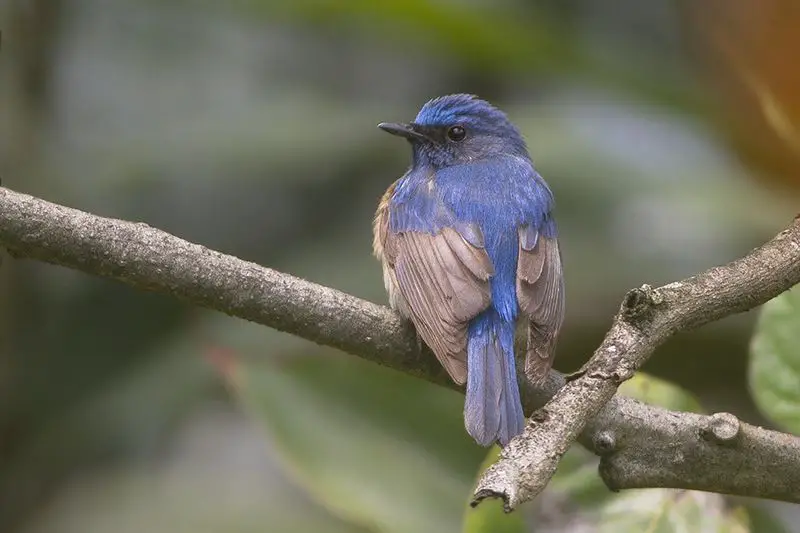
The Blue-Throated Blue Flycatcher graces Kerala’s forests with its vibrant presence. Spot this bird sporting an eye-catching blue throat and orange flanks.
Known scientifically as Cyornis rubeculoides, they inhabit the higher altitudes of Kerala’s lush landscapes. Primarily foraging for insects, they adorn the canopy with lively activity.
Breeding males are particularly striking, featuring vivid plumage. Despite their small size, these flycatchers captivate birdwatchers and add to the avian splendor of the region.
Scientific classification:
| Kingdom | Animalia |
| Phylum | Chordata |
| Class | Aves |
| Order | Passeriformes |
| Family | Muscicapidae |
| Genus | Cyornis |
| Species | C. rubeculoides |
Also Featured In: Bhutan birds,
26. Ashy Drongo
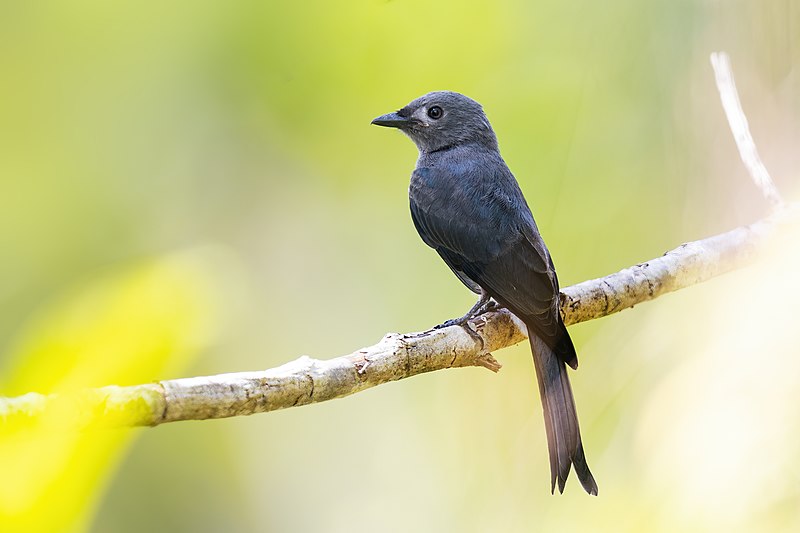
The Ashy Drongo, scientifically called Dicrurus leucophaeus, frequents Kerala’s diverse woodlands. Recognized by its bluish-gray plumage, this bird showcases remarkable aerial skills.
Foraging primarily on insects, it adeptly catches prey mid-air. With a distinctly forked tail, the Ashy Drongo can mimic other birds’ calls.
Observers often admire it perched high in trees, contributing to Kerala’s rich avian tapestry.
Scientific classification:
| Kingdom | Animalia |
| Phylum | Chordata |
| Class | Aves |
| Order | Passeriformes |
| Family | Dicruridae |
| Genus | Dicrurus |
| Species | D. leucophaeus |
Also Featured In: Brunei Darussalam Birds, Birds that Live in Borneo Island
27. Red-Rumped Swallow
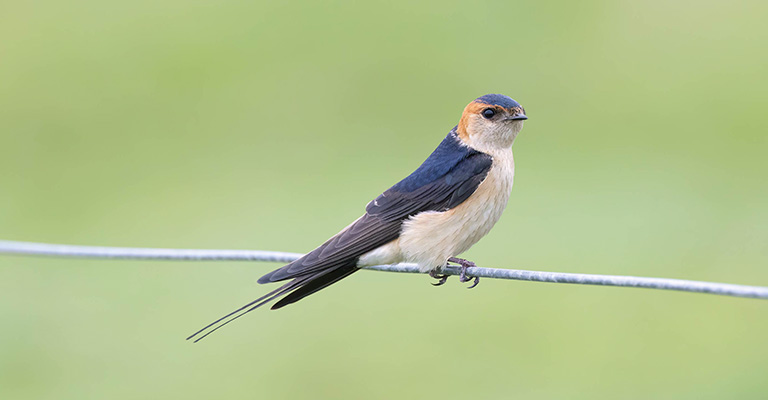
The Red-Rumped Swallow enchants observers in Kerala with its striking appearance. Known scientifically as Cecropis daurica, this bird features a distinctive red rump that contrasts beautifully with its blue-black upperparts.
Found in open fields and near human habitation, it swiftly darts through the air, showcasing its remarkable aerial agility.
This swallow constructs its mud nests under eaves or on cliffs, offering a glimpse into its nesting behavior. Feeding primarily on insects, the Red-Rumped Swallow plays a vital role in pest control, enhancing Kerala’s ecosystem.
Scientific classification:
| Kingdom | Animalia |
| Phylum | Chordata |
| Class | Aves |
| Order | Passeriformes |
| Family | Hirundinidae |
| Genus | Cecropis |
| Species | C. daurica |
Also Featured In: Swallows Species, Birds Live in Tunisia
28. Shikra
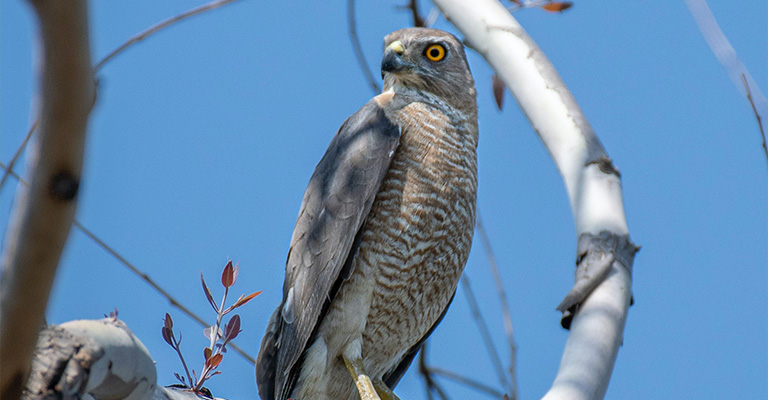
Easily spotted within the forests of Kerala, the Shikra captures attention with its piercing gaze and agile flight.
Found amid dense foliage, these raptors hunt small mammals and birds with exceptional precision.
Their striking red eyes and banded underparts set them apart from other birds of prey. Typically, they build nests high in trees, ensuring safety for their young.
Observers often admire their soaring maneuvers, a common spectacle above Kerala’s vibrant landscapes. Conservation efforts remain crucial to protect their thriving populations in the region.
Scientific classification:
| Kingdom | Animalia |
| Phylum | Chordata |
| Class | Aves |
| Order | Accipitriformes |
| Family | Accipitridae |
| Genus | Accipiter |
| Species | A. badius |
Also Featured In: Birds That Live in the Jungle, Native Birds of Kazakhstan
29. Iora
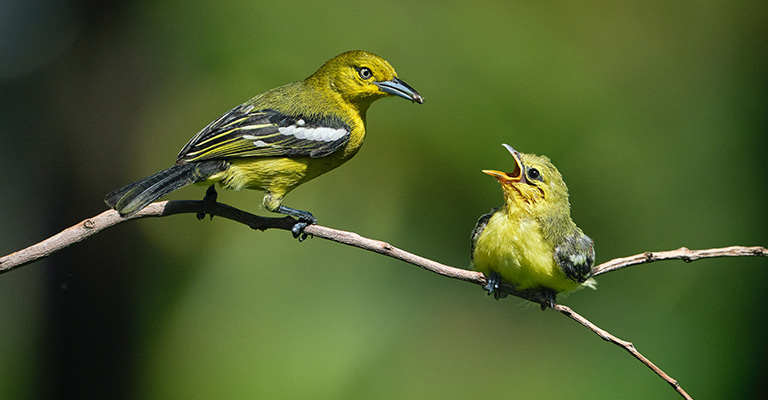
The Common Iora enchants with its vibrant yellow and black plumage. This small bird thrives in Kerala’s dense forests and scrublands.
Known for their melodious calls, Ioras sing harmoniously from treetops. Typically, they forage in pairs searching for insects and fruits.
These active birds often join mixed-species flocks, enhancing their presence. During breeding season, they build cup-shaped nests, skillfully camouflaged among leaves.
Conservation efforts help maintain their habitats, ensuring their cheerful songs continue to echo across the region.
Scientific classification:
| Kingdom | Animalia |
| Phylum | Chordata |
| Class | Aves |
| Order | Passeriformes |
| Superfamily | Malaconotoidea |
| Family | Aegithinidae G. R. Gray, 1869 |
| Genus | Aegithina Vieillot, 1816 |
Also Featured In: Asian Birds, Birds that Live in Tamil Nadu
30. White-Cheeked Barbet
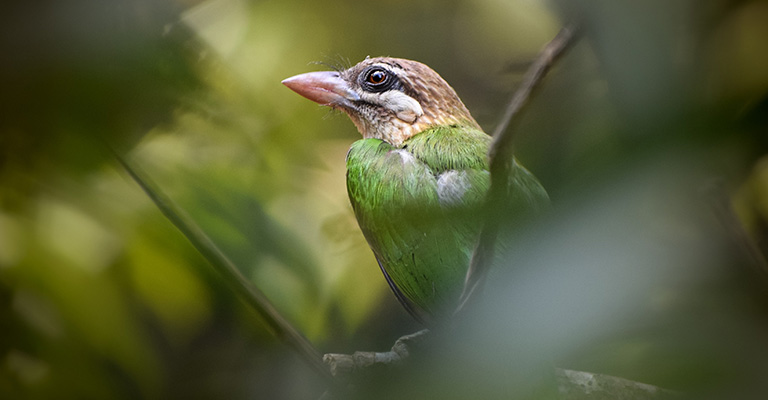
Kerala’s lush landscapes are home to the White-Cheeked Barbet, a vibrant bird species. Known scientifically as Psilopogon viridis, this bird is easily identified by its striking white cheeks and vivid green plumage.
Found frequently in the state’s evergreen forests and gardens, they thrive in a diverse range of habitats. These barbets play a crucial role in the ecosystem, mainly feeding on fruits and occasionally insects.
With their distinctive calls, White-Cheeked Barbets add a musical element to Kerala’s biodiversity. Conservation of their forests ensures their continued presence.
Scientific classification:
| Kingdom | Animalia |
| Phylum | Chordata |
| Class | Aves |
| Order | Piciformes |
| Family | Megalaimidae |
| Genus | Psilopogon |
| Species | P. viridis |
Also Featured In: Birds of Goa, Common Birds in Bangalore
31. Jungle Owlet
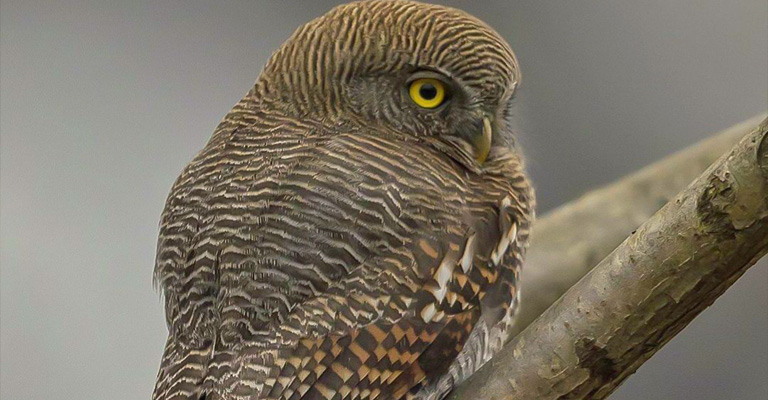
Nestled within Kerala’s lush forests, the Jungle Owlet, scientifically known as Glaucidium radiatum, enchants bird enthusiasts with its distinctive appearance.
This petite owl boasts striking yellow eyes and a round facial disk, aiding its nocturnal vision. Often found perched on tree branches, its camouflage is aided by the dappled sunlight filtering through the canopy.
Feeding primarily on insects and small mammals, Jungle Owlets play a critical role in controlling pest populations, benefiting Kerala’s diverse ecosystems. Conservation efforts ensure their continued presence in Kerala’s vibrant landscapes.
Scientific classification:
| Kingdom | Animalia |
| Phylum | Chordata |
| Class | Aves |
| Order | Strigiformes |
| Family | Strigidae |
| Genus | Glaucidium |
| Species | G. radiatum |
Also Featured In: Gujarati Birds, Common Birds that Live in Odisha
32. Chestnut-Headed Bee-Eater
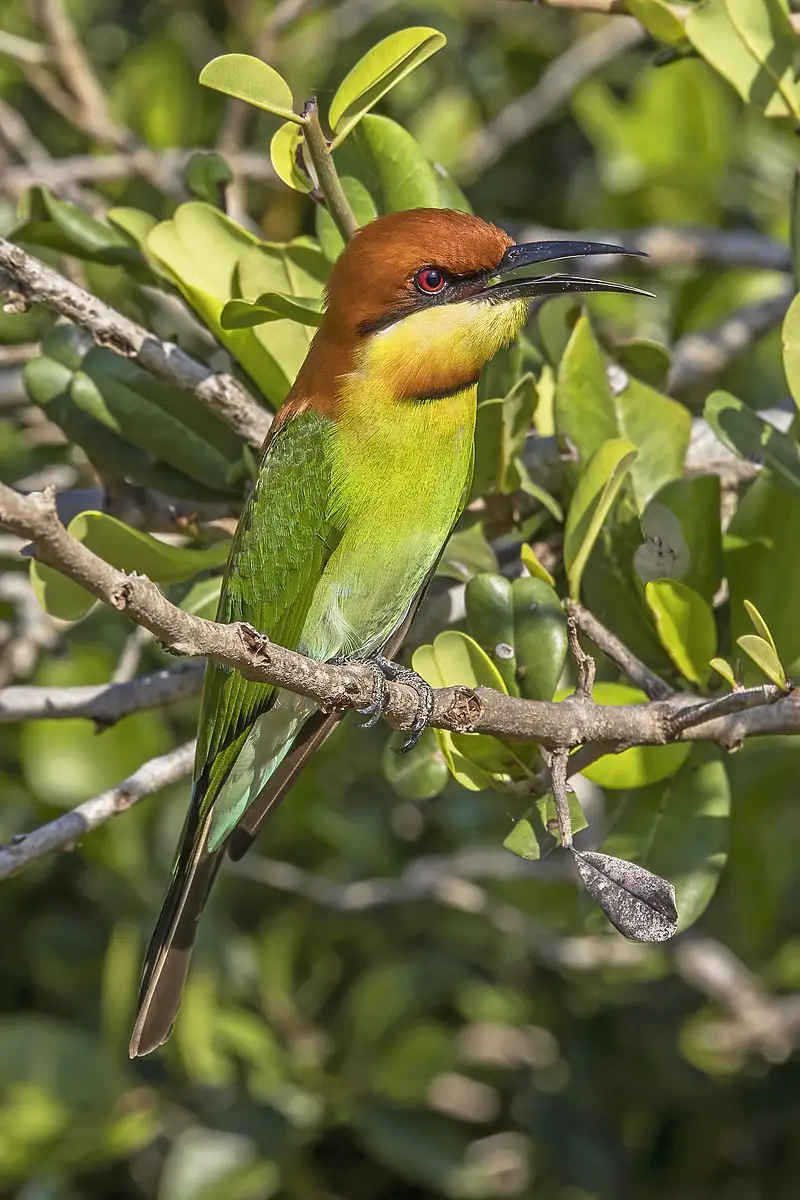
Displaying a vibrant blend of colors, the Chestnut-Headed Bee-Eater inhabits Kerala’s forests and open woodlands. It flaunts a striking chestnut crown and green wings, making it a visual delight.
Often seen in flocks, they enjoy hawking insects mid-flight. Known for their agile aerial maneuvers, these birds contribute to pest control.
They extend the bee-eater’s charm with their vibrant plumage and captivating presence in India’s lush landscapes. Conservation efforts for these birds help maintain the balance in local ecosystems.
Scientific classification:
| Kingdom | Animalia |
| Phylum | Chordata |
| Class | Aves |
| Order | Coraciiformes |
| Family | Meropidae |
| Genus | Merops |
| Species | M. leschenaulti |
Also Featured In: Common Birds of Chhattisgarh,
33. Blue-Winged Parakeet
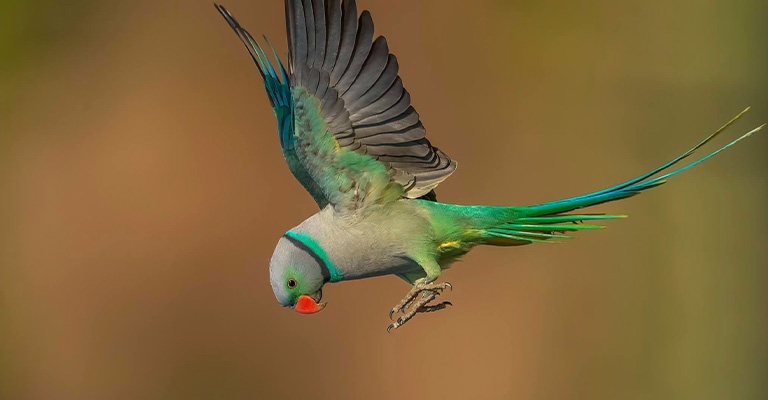
The Blue-Winged Parakeet, also called the Malabar Parakeet, thrives in Kerala’s evergreen forests. Often seen in small flocks, their vibrant blue wings are a striking feature against their greenish body.
These parakeets prefer low country areas, occasionally mingling with other species like the Blossom-Headed Parakeet.
Their adaptation to both deciduous and evergreen forests highlights their versatility. Maintaining their habitats is crucial for preserving their presence in Kerala’s rich biodiversity.
Scientific classification:
| Kingdom | Animalia |
| Phylum | Chordata |
| Class | Aves |
| Order | Psittaciformes |
| Family | Psittaculidae |
| Genus | Psittacula |
| Species | P. columboides |
Also Featured In: Pet Birds that Live in India,
34. White-Bellied Treepie
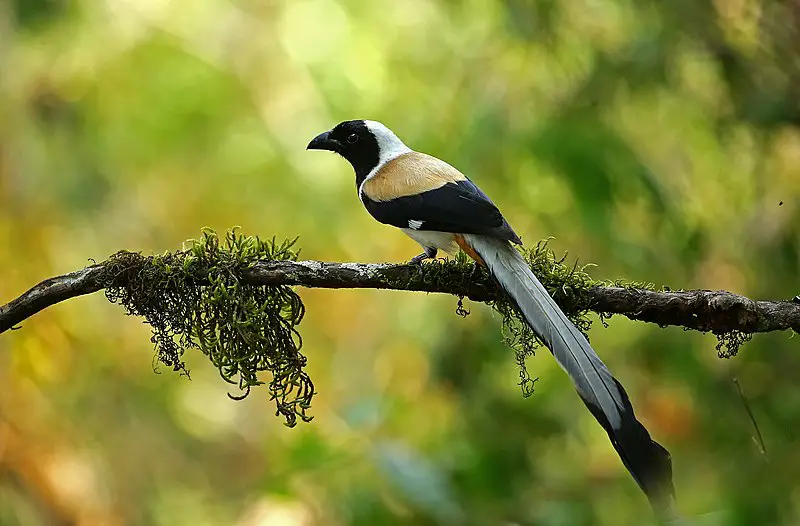
A bird distinguished by its loud metallic calls often seen in Kerala’s evergreen rainforests. They thrive from the foothills to elevations of 3,500 ft and beyond.
Typically spotted in pairs or small family groups, these birds actively join mixed hunting parties. Their presence adds vibrancy to the forests’ soundscape.
With their striking appearance, they’re a fascinating sight within diverse avian assemblies. The White-Bellied Treepie’s unique role in the ecosystem highlights the importance of conserving its natural habitats.
Scientific classification:
| Kingdom | Animalia |
| Phylum | Chordata |
| Class | Aves |
| Order | Passeriformes |
| Family | Corvidae |
| Genus | Dendrocitta |
| Species | D. leucogastra |
35. White-bellied blue Flycatcher
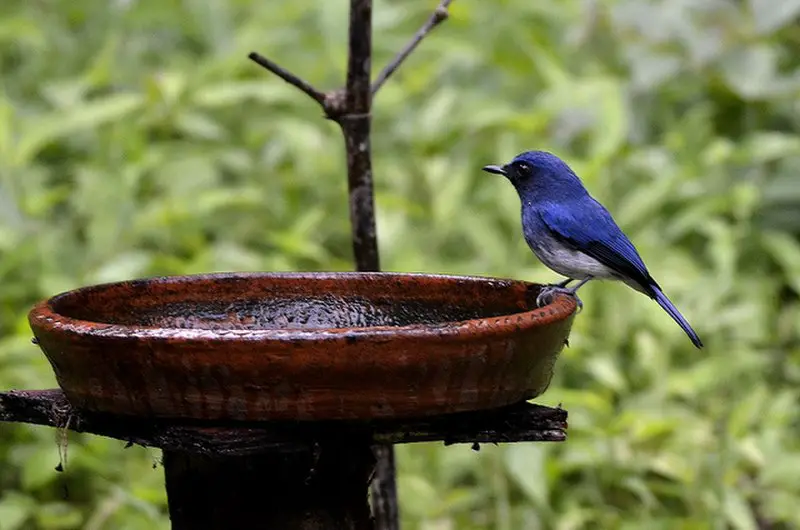
Every birdwatcher in Kerala dreams of spotting the White-Bellied Blue Flycatcher. This exquisite bird, marked by its indigo blue hue, is primarily found in the misty shola forests above 3,000 feet.
Recognizable by its striking white belly, it thrives amidst dense vegetation. Female flycatchers differ slightly, showing a pale brown shade with chestnut-colored tails.
Their quiet yet melodious notes echo through the undergrowth, enchanting all who listen.
Scientific classification:
| Kingdom | Animalia |
| Phylum | Chordata |
| Class | Aves |
| Order | Passeriformes |
| Family | Muscicapidae |
| Genus | Cyornis |
| Species | C. pallidipes |
36. Malabar Grey Hornbill
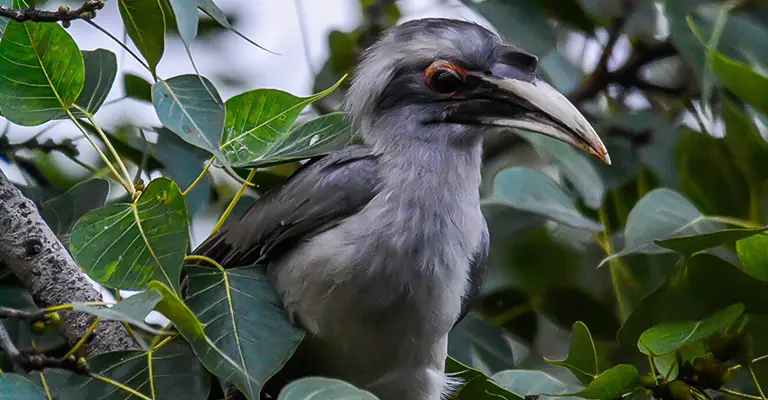
The Malabar Grey Hornbill flourishes in Kerala’s evergreen forests. It displays a distinctive grey plumage and an elegantly curved bill.
These hornbills make their homes in tall trees, where they help in seed dispersal. Their preferred diet includes fruits, occasionally small insects, contributing to forest health.
Observers often spot them in pairs or small groups in the Western Ghats. Their adaptability to their environment underlines their role in Kerala’s ecosystem.
Conservation efforts aim to safeguard their habitats, ensuring their ongoing presence in the region.
Scientific classification:
| Kingdom | Animalia |
| Phylum | Chordata |
| Class | Aves |
| Order | Bucerotiformes |
| Family | Bucerotidae |
| Genus | Ocyceros |
| Species | O. griseus |
37. Indian Pitta
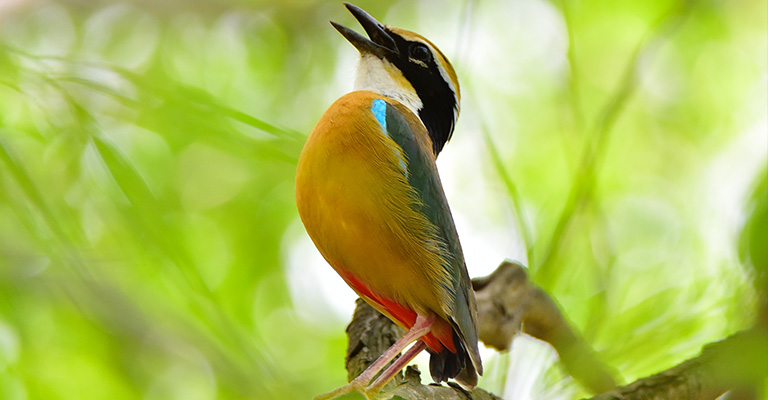
Indian Pitta enchants with its colorful plumage, featuring vibrant greens, blues, and russets. These elusive birds are most often seen in the wooded regions of Kerala.
Known for their distinctive two-note whistle, Indian Pittas perch quietly on low branches. They forage on the forest floor, often flipping leaves in search of insects and snails.
Migration takes them across the Indian subcontinent, marking their presence in Kerala primarily during the breeding season. Conservation of forest habitats remains crucial for their survival.
Scientific classification:
| Kingdom | Animalia |
| Phylum | Chordata |
| Class | Aves |
| Order | Passeriformes |
| Family | Pittidae |
| Genus | Pitta |
| Species | P. brachyura |
Also Featured In: Birds that Migrate to Sri Lankan, Most Common Madhya Pradesh Birds
Conclusion
Kerala stands as a sanctuary for bird enthusiasts, offering a vibrant tapestry of avian life that enriches its lush landscapes.
The state’s commitment to conservation is vital in safeguarding the diverse bird species that call it home.
From the agile Shikra to the melodious Common Iora, each bird contributes uniquely to the ecosystem’s balance.
As Kerala continues to attract both casual birdwatchers and seasoned ornithologists, the ongoing efforts to preserve these habitats ensure that the region’s natural beauty and biodiversity remain a treasure for generations to come.